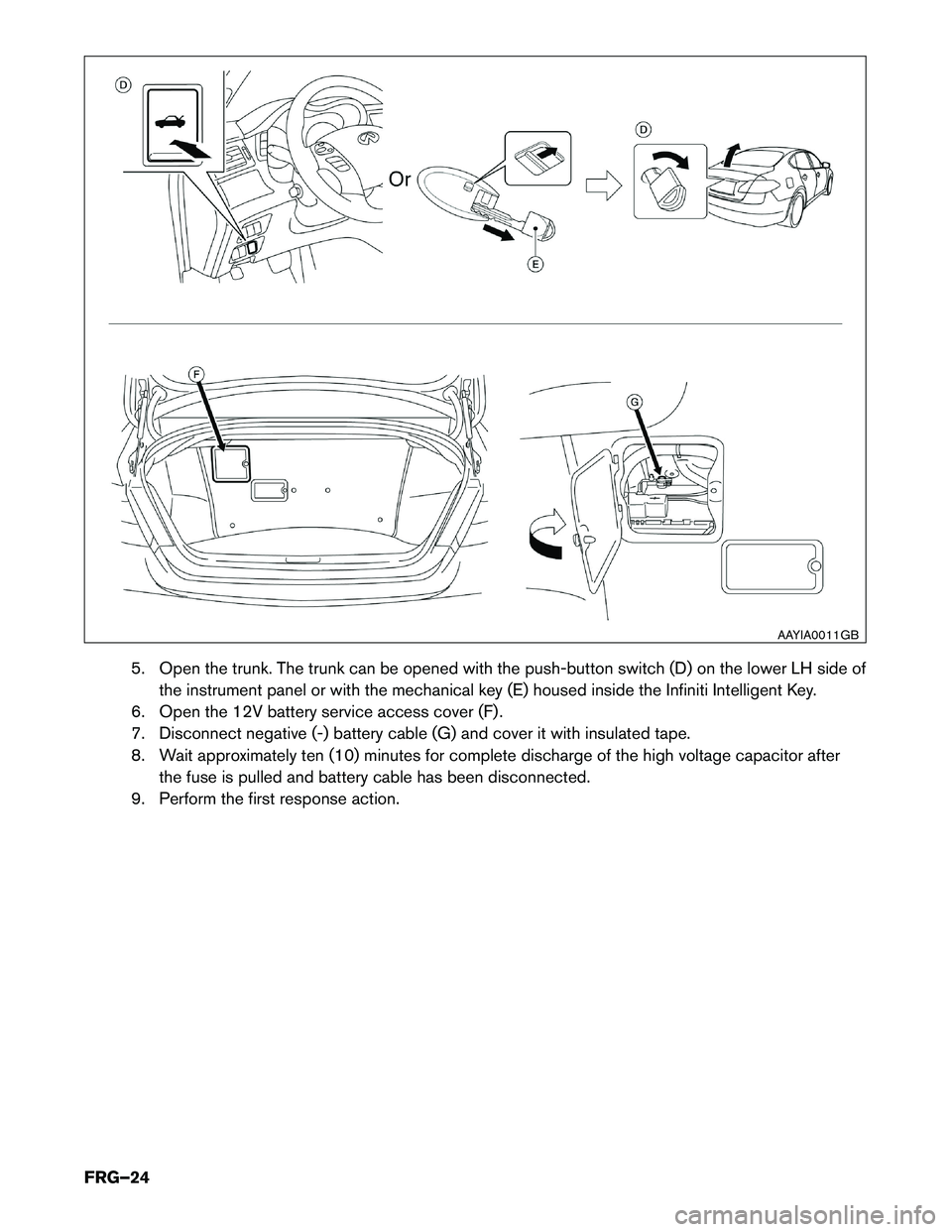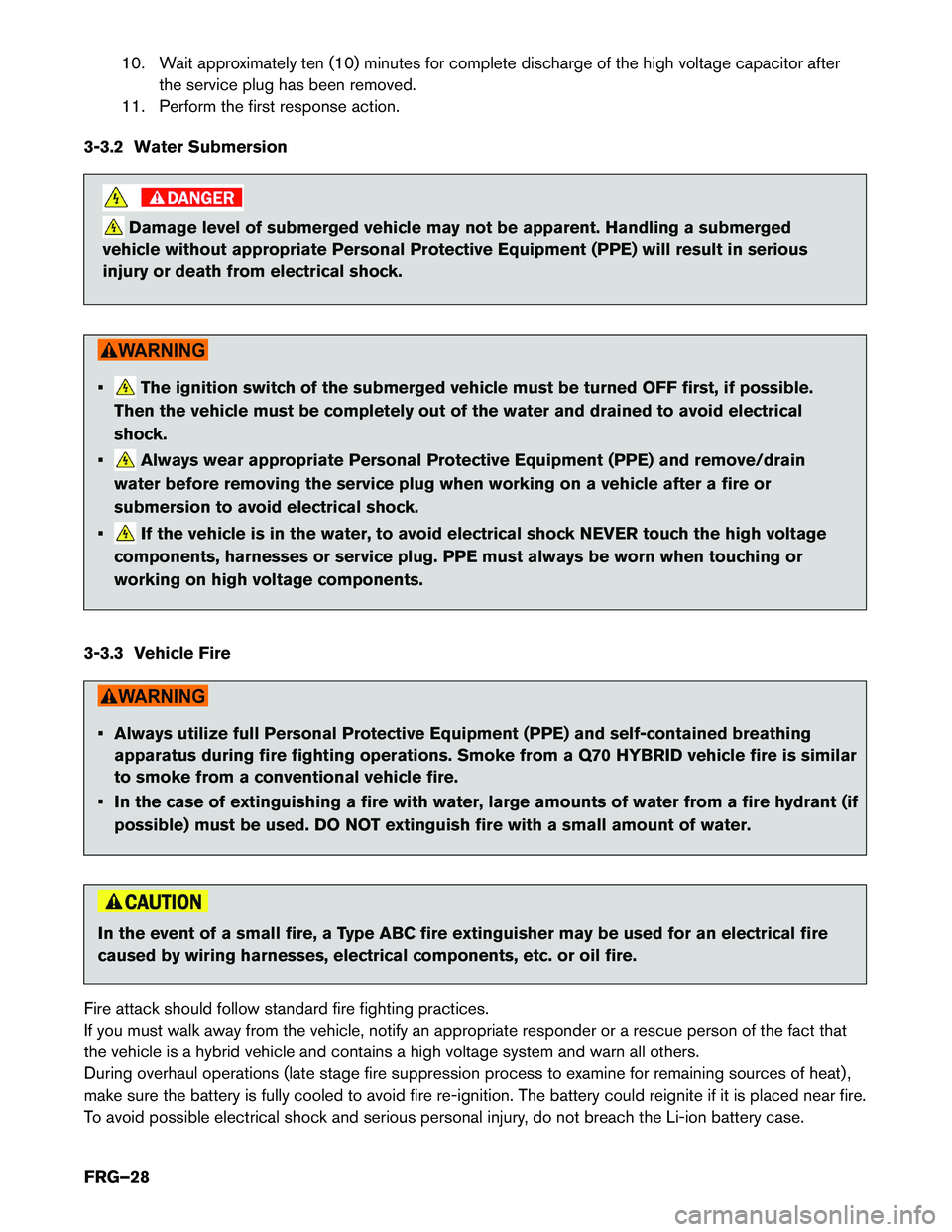ESP INFINITI Q70 HYBRID 2014 First Responder´s
[x] Cancel search | Manufacturer: INFINITI, Model Year: 2014, Model line: Q70 HYBRID, Model: INFINITI Q70 HYBRID 2014Pages: 41, PDF Size: 5.09 MB
Page 24 of 41

5. Open the trunk. The trunk can be opened with the push-button switch (D) on the lower LH side of
the instrument panel or with the mechanical key (E) housed inside the Infiniti Intelligent Key.
6. Open the 12V battery service access cover (F) .
7. Disconnect negative (-) battery cable (G) and cover it with insulated tape.
8. Wait approximately ten (10) minutes for complete discharge of the high voltage capacitor after the fuse is pulled and battery cable has been disconnected.
9. Perform the first response action. AAYIA0011GB
FRG–24
Page 25 of 41

Alternate Procedure 2 (Remove Service Plug)
• Do not remove the service plug without always wearing appropriate Personal
Protective Equipment (PPE) to help protect the responder from serious injury or death
by electrical shock.
• Immediately cover the service plug socket with insulated tape. The Li-ion battery
retains
high voltage power even when the service plug is removed. To avoid electric
shock, NEVER touch the terminals inside the socket. To avoid unintended reinstallation and risk of electrical shock and severe personal injury
or
death, the rescuer should carry the service plug on his/her person while work is in
progress.
NOTE: Before disconnecting the 12V battery terminal, if necessary, lower the windows, adjust the
steering column, adjust the seats, unlock the doors, etc. Once 12V battery is disconnected,
power controls will not operate.
1. Check the READY indicator (A) status in the instrument cluster. If it is on, the high voltage systemis active.
2. Place the shift selector in the Park (P) position.
3. Push the ignition switch (B) once to turn OFF the high voltage system. Then verify whether the READY indicator (A) is off.
If the READY indicator (A) does not turn off, continue to the next steps to open the trunk for 12V
battery negative cable access. AAYIA0062ZZ
FRG–25
Page 28 of 41

10. Wait approximately ten (10) minutes for complete discharge of the high voltage capacitor after
the service plug has been removed.
11. Perform the first response action.
3-3.2 Water Submersion Damage level of submerged vehicle may not be apparent. Handling a submerged
vehicle
without appropriate Personal Protective Equipment (PPE) will result in serious
injury or death from electrical shock. • The ignition switch of the submerged vehicle must be turned OFF first, if possible.
Then
the vehicle must be completely out of the water and drained to avoid electrical
shock.
• Always wear appropriate Personal Protective Equipment (PPE) and remove/drain
water
before removing the service plug when working on a vehicle after a fire or
submersion to avoid electrical shock.
• If the vehicle is in the water, to avoid electrical shock NEVER touch the high voltage
components,
harnesses or service plug. PPE must always be worn when touching or
working on high voltage components.
3-3.3 Vehicle Fire • Always utilize full Personal Protective Equipment (PPE) and self-contained breathing
apparatus
during fire fighting operations. Smoke from a Q70 HYBRID vehicle fire is similar
to smoke from a conventional vehicle fire.
• In the case of extinguishing a fire with water, large amounts of water from a fire hydrant (if possible) must be used. DO NOT extinguish fire with a small amount of water. In the event of a small fire, a Type ABC fire extinguisher may be used for an electrical fire
caused
by wiring harnesses, electrical components, etc. or oil fire.
Fire attack should follow standard fire fighting practices.
If you must walk away from the vehicle, notify an appropriate responder or a rescue person of the fact that
the vehicle is a hybrid vehicle and contains a high voltage system and warn all others.
During overhaul operations (late stage fire suppression process to examine for remaining sources of heat) ,
make sure the battery is fully cooled to avoid fire re-ignition. The battery could reignite if it is placed near fire.
To avoid possible electrical shock and serious personal injury, do not breach the Li-ion battery case.
FRG–28
Page 34 of 41

3-3.5 Li-ion Battery Damage and Fluid Leaks
The Li-ion battery contains electrolyte solution. To avoid exposure to electrolyte solution
and
serious personal injury, always wear appropriate solvent resistant Personal Protective
Equipment (PPE) and read the following precautions:
• Electrolyte solution is a skin irritant.
• Electrolyte solution is an eye irritant – If contact with eyes, rinse with plenty of water and
see a doctor immediately.
• If electrolyte leak occurs, wear appropriate solvent resistant PPE and use a dry cloth to clean up the spilled electrolyte. Be sure to adequately ventilate the area.
• Electrolyte solution is highly flammable
• Electrolyte liquid or fumes that have come into contact with water vapors in the air will create an oxidized substance. This substance may irritate skin and eyes. In these cases,
rinse with plenty of water and see a doctor immediately.
• Electrolyte fumes (when inhaled) can cause respiratory irritation and acute intoxication. Move to fresh air and wash mouth with water. See a doctor immediately.
If electrolyte solution leakage, or damage such as any problem with the Li-ion battery casing are observed,
first responders should attempt to neutralize the battery by applying a large volume of water to the battery
pack while wearing appropriate Personal Protective Equipment (PPE) . The neutralization process helps
stabilize the thermal condition of the battery pack but does not discharge the battery.
Li-ion Battery Electrolyte Solution Characteristics: • Clear in color
• Sweet odor
• Similar viscosity to water
• Since the Li-ion battery is made up of many small sealed battery modules, electrolyte solutionleakage should be minimal.
NOTE:
Other fluids in the vehicle (such as engine oil, washer fluid, brake fluid, coolant, etc.) are
the same as those in a conventional vehicle.
FRG–34